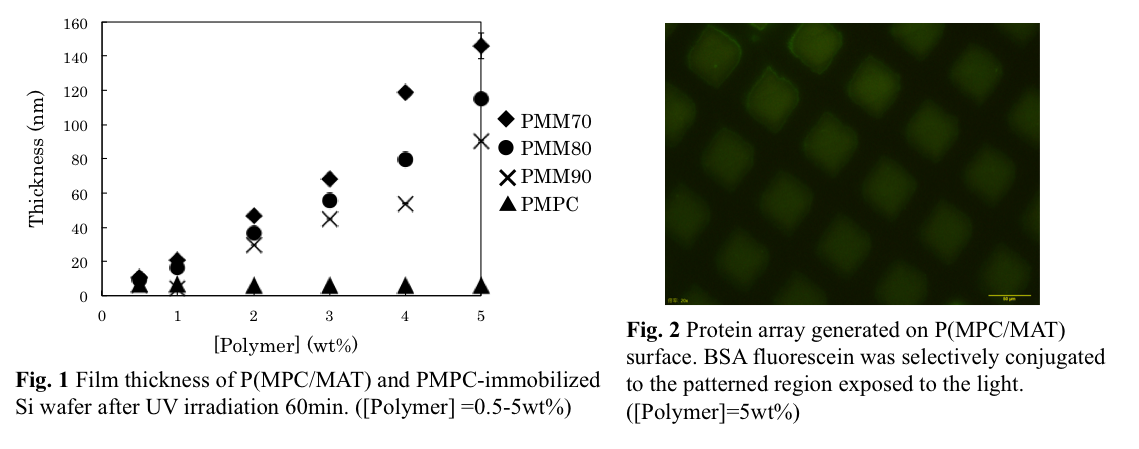Introduction: Control of protein adsorption on synthetic materials is still important issue for creation of biomedical materials. It is well known that 2-methacryloyloxyethyl phosphorylcholine (MPC) polymers can reduce nonspecific protein adsorption. By adding ligands to MPC polymer surfaces, specific molecular interaction between the surface and proteins or cells could be regulated [1]. In the present study, the photo-reactive MPC polymers bearing tyrosine residues have been newly synthesized. The coating layer of MPC copolymers having tyrosine residues was formed on the solid substrates via UV-irradiation through the binding between oxidized tyrosine residues [2] and the substrate. The nonfouling property on the substrates was improved by the surface modification. Moreover, the protein immobilization through oxidized tyrosine [3] on the MPC copolymers having high composition of tyrosine residues have been performed.
Material and Method: Poly(MPC) (PMPC) and MPC copolymers with N-methacryloyl-(L)-tyrosine methylestr(MAT) (P(MPC/MAT)) were synthesized by conventional radical polymerization. The aqueous solution containing 1wt% P(MPC/MAT) was coated on the silicon wafers using a spin coater. The specimens were irradiated UV light (254 nm) for several periods and rinsed with methanol and water. Surface analysis for P(MPC/MAT)-immobilized surfaces was performed using X-ray photoelectron spectroscope (XPS) and ellipsometer. P(MPC/MAT)-immobilized specimens were exposed to 0.45 g/dL fluorescein isothiocyanate (FITC)-labeled bovine albumin in PBS for 30 min, and rinsed with PBS and water. The sample was dried in an argon stream and observed using a fluorescent microscope.
Results: The molar fraction of MPC of P(MPC/MAT) was coincident with that in copolymers. Oxidation of tyrosine units via UV light irradiation was monitored using UV-visible spectrophotometer. Fig. 1 shows the thickness of polymer layers immobilized on Si wafers. When the UV irradiation time was adjusted at 60 min, the thickness of P(MPC/MAT) coated on Si wafers was increased with an increase in the concentration of the polymer solution and the molar fraction of MAT. Fig. 2 shows a fluorescence micrograph for protein microarray generated on P(MPC/MAT)70/30. UV light was irradiated on P(MPC/MAT)70/30 coated surface was through a mesh for transmission electron microscopy. The proteins attached on the specific regions whose surface were exposed to UV light.

Discussion: Considering from the layer thickness and phosphorus composition of surface analysis, MAT of P(MPC/MAT) is dominant unit to regulate the feature of polymer layers. Oxidized MAT units showed an advantage not only for the polymer adhesion to a solid surface but also protein conjugation with the adherent polymer. The amount of proteins immobilized on oxidized P(MPC/MAT)70/30 increased with an increase in the thickness of the polymer layer. It has been also clarified that conjugation of proteins on P(MPC/MAT) was selectively occurred through the oxidized MAT units.
Conclusion: The photo-reactive MPC polymers have been newly designed to generate biofunctional interface. Tyrosine residues incorporated MPC copolymers could be photooxidized and resulted polymers showed functions to bind on solid surfaces and conjugate with proteins. The activity of site-specifically immobilized proteins on MPC polymer surface was well preserved. Moreover, nonspecific biofouling on the surface well reduced. The photo-reactive MPC polymers will be useful for surface preparation of biomedical and diagnostic devices.
A part of this work was supported by AMED Strategic Promotion of Innovative Research and Development
References:
[1] K. Ishihara et al., J. Biomed. Mater. Res. 1998, 39, 323-330
[2] P. Mazellier et al., Photochem. Photobiol. Sci. 2003, 2, 946-953
[3] M. E.Lynge et al., Nanoscale 2011, 3, 4916-4928